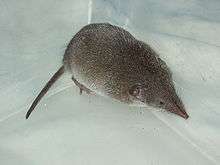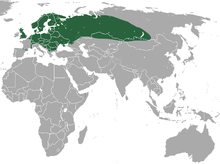Common shrew
| Common shrew[1] | |
|---|---|
 | |
| Common shrew (Sorex araneus) | |
| Scientific classification | |
| Kingdom: | Animalia |
| Phylum: | Chordata |
| Class: | Mammalia |
| Order: | Eulipotyphla |
| Family: | Soricidae |
| Genus: | Sorex |
| Species: | S. araneus |
| Binomial name | |
| Sorex araneus Linnaeus, 1758 | |
 | |
| Common shrew range | |
The common shrew (Sorex araneus) or Eurasian shrew is the most common shrew, and one of the most common mammals, throughout Northern Europe, including Great Britain, but excluding Ireland.[3] It is 55–82 millimetres (2.2–3.2 in) long and weighs 5–12 grams (0.2–0.4 oz), and has velvety dark brown fur with a pale underside. Juvenile shrews have lighter fur until their first moult. The common shrew has small eyes, a pointed, mobile snout and red-tipped teeth. It has a life span of approximately 14 months.
Shrews are active day and night, but mostly after dark. They are active most of the time, resting for only a few minutes between bursts of activity.
Territory
The common shrew is found in the woodlands, grasslands, and hedgelands of Britain, Scandinavia, and Eastern Europe. Each shrew establishes a home range of 370–630 square metres (440–750 sq yd). Males extend these boundaries only during breeding season, to find females. The common shrew is extremely territorial and becomes aggressive when another shrew enters its home range. It makes its nest underground or under dense vegetation.[4]
Diet
The shrew's carnivorous and insectivorous diet consists mostly of insects, slugs, spiders, worms, amphibians and small rodents. Shrews need to consume 200-300% of their body weight each day in order to survive. A shrew must eat every two to three hours to achieve this goal. This means that a shrew may starve if it finds no food for as little as 5 hours. They do not hibernate in the winter months because their bodies are too small to hold sufficient fat reserves.
Shrews have poor eyesight, but use their excellent sense of smell and good hearing to locate food. Using these senses, a shrew can locate prey up to 12 centimetres (5 in) deep in the soil.
Breeding
The common shrew breeding season lasts from April to September, but peaks during the summer months. After a gestation period of 24 to 25 days, a female gives birth to a litter of five to seven baby shrews. A female usually rears two to four litters each year. The young are weaned and independent by 22 to 25 days.[5]
Breeding is the only time that shrews do not prefer to be solitary. Young shrews often form a caravan behind the mother, each carrying the tail of the sibling in front with its mouth.
Chromosomal polymorphism
The chromosome number (karyotype) of Sorex araneus varies widely, with a number of distinct "chromosomal races" being present over the species' range.[2] One such race was described in 2002 as a new species, S. antinorii.[2] This is an example of chromosomal polymorphism;[6] the variability occurs as a result of chromosome fusions or disassociations.[7]
Protection and population

The common shrew is not an endangered species, but in Great Britain it, like other shrews, is protected from certain methods of killing by the Wildlife and Countryside Act of 1981.[8]
In Britain, shrews can be found at densities up to one per 200 square metres (240 sq yd) in woodlands. The population is controlled by many predators including owls, weasels, stoats, and foxes. A liquid produced by glands on the skin makes shrews taste rather unpleasant to domestic cats.[4]
References
- ↑ Hutterer, R. (2005). "Order Soricomorpha". In Wilson, D.E.; Reeder, D.M. Mammal Species of the World: A Taxonomic and Geographic Reference (3rd ed.). Johns Hopkins University Press. p. 283. ISBN 978-0-8018-8221-0. OCLC 62265494.
- 1 2 3 Hutterer, R.; Amori, G. & Kryštufek, B. (2008). "Sorex araneus". IUCN Red List of Threatened Species. Version 2011.2. International Union for Conservation of Nature. Retrieved 31 December 2011.
- ↑ http://www.birdwatchireland.ie/Publications/eWings/eWingsIssue58July2014/IrelandsPygmyShrewsunderthreatfrominvader/tabid/1403/Default.aspx
- 1 2 British Wildlife. London: Collins. 2002. p. 402. ISBN 0 00 713716 8.
- ↑ "BBC Science and Nature: Animals". Retrieved 11 September 2009.
- ↑ Polymorphism: when two or more clearly different phenotypes exist in the same interbreeding population of a species. Ford E.B. 1975. Ecological genetics, 4th ed.
- ↑ White M.J.D. 1973. The chromosomes. Chapman & Hall, London. p169
- ↑ Wildlife and Countryside Act 1981 S11, Sch 6
External links
- ARKive on the Common Shrew
- BBC information on the Common Shrew
- View the shrew genome in Ensembl
- View the sorAra2 genome assembly in the UCSC Genome Browser.
- The IUCN Red List of Threatened Species entry about the Common Shrew
